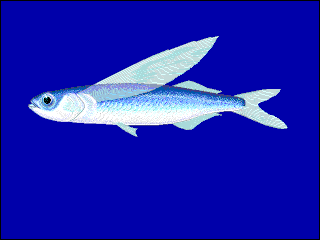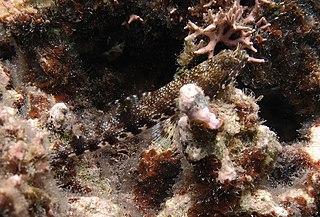
Cyprinodontiformes is an order of ray-finned fish, comprising mostly small, freshwater fish. Many popular aquarium fish, such as killifish and live-bearers, are included. They are closely related to the Atheriniformes and are occasionally included with them. A colloquial term for the order as a whole is toothcarps, though they are not actually close relatives of the true carps – the latter belong to the superorder Ostariophysi, while the toothcarps are Acanthopterygii.

Mackerel is a common name applied to a number of different species of pelagic fish, mostly from the family Scombridae. They are found in both temperate and tropical seas, mostly living along the coast or offshore in the oceanic environment.
Hemiramphidae is a family of fishes that are commonly called halfbeaks, spipe fish or spipefish. They are a geographically widespread and numerically abundant family of epipelagic fish inhabiting warm waters around the world. The halfbeaks are named for their distinctive jaws, in which the lower jaws are significantly longer than the upper jaws. The similar viviparous halfbeaks have often been included in this family.

Beloniformes is an order composed of six families of freshwater and marine ray-finned fish:

Needlefish or long toms are piscivorous fishes primarily associated with very shallow marine habitats or the surface of the open sea. Some genera include species found in marine, brackish, and freshwater environments, while a few genera are confined to freshwater rivers and streams, including Belonion, Potamorrhaphis, and Xenentodon. Needlefish closely resemble North American freshwater gars in being elongated and having long, narrow jaws filled with sharp teeth, and some species of needlefishes are referred to as gars or garfish despite being only distantly related to the true gars. In fact, the name "garfish" was originally used for the needlefish Belone belone in Europe and only later applied to the North American fishes by European settlers during the 18th century.
Sauries are fish of the family Scomberesocidae. There are two genera, each containing two species. The name Scomberesocidae is derived from the scomber, which in turn is derived from the Greek skombros, meaning "mackerel", and the Latin esox meaning pike.
The Pacific saury is a member of the family Scomberesocidae. Saury is a seafood in several East Asian cuisines and is also known by the name mackerel pike.

Pelagic fish live in the pelagic zone of ocean or lake waters – being neither close to the bottom nor near the shore – in contrast with demersal fish that do live on or near the bottom, and reef fish that are associated with coral reefs.

The Emmelichthyidae are a family of small to medium-sized marine fish known commonly as rovers. The family was once much larger, including a wide range of plankton-eating fish, but most of the genera were discovered to be unrelated examples of parallel evolution, and were moved to other families.
Cololabis is a genus of sauries found in the eastern and northern Pacific Ocean. The name is derived from the Greek word kolos, meaning "short", and the Latin word labis, meaning "forceps", referring to the short beak of the type species Scombresox brevirostris.

An anchovy is a small, common forage fish of the family Engraulidae. Most species are found in marine waters, but several will enter brackish water, and some in South America are restricted to fresh water.
The Wanieso lizardfish(Saurida wanieso) or Wanieso saury, is a species of lizardfish that lives in the Indo-Pacific region.
Saurida umeyoshii is a species of lizardfish that lives in the Pacific Ocean.

The clouded lizardfish(Saurida nebulosa) is a species of lizardfish that lives mainly in the south Pacific Ocean.
The longfin lizardfish(Saurida longimanus), also known as the longfin saury, is a species of lizardfish that lives in the Indo-Pacific.
The shortjaw saury(Saurida isarankurai) is a species of lizardfish that lives mainly in the Pacific Ocean.
The orangemouth lizardfish(Saurida flamma) is a species of lizardfish that lives mainly in the Eastern Central Pacific.
The shortfin saury, Saurida argentea, is a species of lizardfish that lives mainly in the western Pacific Ocean.
The speartoothed grinner(Synodus sageneus) is a species of lizardfish that lives mainly in the Indo-West Pacific.
Platanichthys platana, the Rio Plata sprat, is a very small species of fish belonging to the herring family, Clupeidae. It is endemic to South America. It is the only species in its genus.








